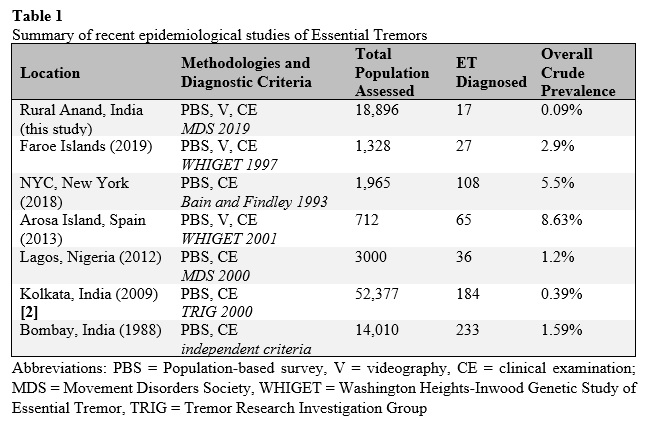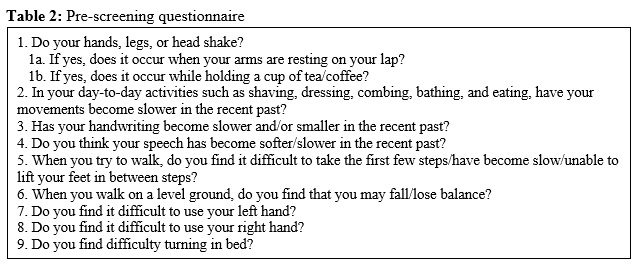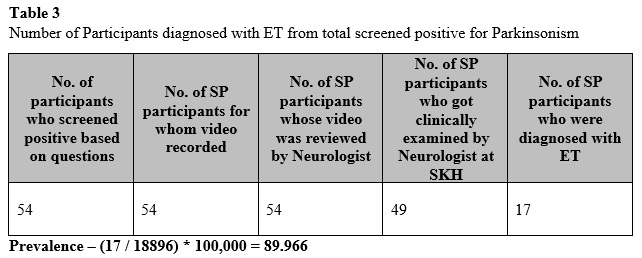Category: Epidemiology
Objective: With India’s diverse population, existing epidemiological surveys about neurologic disorders like essential tremors (ET) cannot be accurately extrapolated, presenting a need for population-based surveys for localized data.
Background: Worldwide crude prevalence rates of ET range from 0.4-8.6% across multiple studies, affecting about 1% of the general population and 4-5% of individuals over 65 years old [Table 1]. Despite such high prevalence rates, the number of studies estimating prevalence of ET is surprisingly low, with no previous studies amongst rural Indian communities.
Method: To assess the prevalence of ET in this population, we utilized a pre-validated modified screening questionnaire [Table 2] to screen every household in 10 selected villages of Anand district in rural Gujarat in the western part of India for parkinsonism and movement disorders including ET [1]. Participants who screened positive underwent videography review and detailed clinical examination by neurologist to confirm the diagnosis of ET based on 2019 MDS Tremor Task Force diagnostic criteria.
Results: A total of 18,896 individuals were screened from 5,990 families in the region. 54 participants who screened positive underwent formal neurologic evaluation and 17 were eventually diagnosed with ET [Table 3]. The crude prevalence of ET in this population was calculated as 89.96 per 100,000 (0.09%), reporting based on 2019 MDS tremor classification criteria gathered from household survey screening, video recordings and clinical evaluation by a Neurologist. No associations were found to be statistically significant with regards to participants’ labor patterns, agricultural chemical exposure, well water use, or present/past substance use including chewing tobacco, smoking tobacco, alcohol or coffee.
Conclusion: Our study indicates that the rural Gujarat crude prevalence rate of ET is lower in comparison to other studies conducted globally. A reason for lower prevalence in our study could be that we utilized the recently updated criteria to diagnose ET (and excluded patients with ET plus syndromes compared to older studies). Importantly, our study is the only such assessment done in a village-based Indian population. Further studies of ET prevalence utilizing new definition criteria will help improve awareness, diagnosis, and treatment of this condition for the rural Indian population and generate more understanding of ET prevalence throughout India and worldwide.
References: [1] Bhatia KP, Bain P, Bajaj N, et al. Consensus Statement on the classification of tremors. from the task force on tremor of the International Parkinson and Movement Disorder Society. Mov Disord. 2018;33(1):75-87. [2] Das SK, Banerjee TK, Roy T, Raut DK, Chaudhuri A, Hazra A. Prevalence of essential tremor in the city of Kolkata, India: a house-to-house survey. Eur J Neurol. 2009;16(7):801-807.
To cite this abstract in AMA style:
A. Chin, S. Arora, S. Raithata, D. Desai, U. Shah, A. Deb, S. Desai. Prevalence of Essential Tremors in Rural Gujarat, India [abstract]. Mov Disord. 2021; 36 (suppl 1). https://www.mdsabstracts.org/abstract/prevalence-of-essential-tremors-in-rural-gujarat-india/. Accessed December 13, 2025.« Back to MDS Virtual Congress 2021
MDS Abstracts - https://www.mdsabstracts.org/abstract/prevalence-of-essential-tremors-in-rural-gujarat-india/



